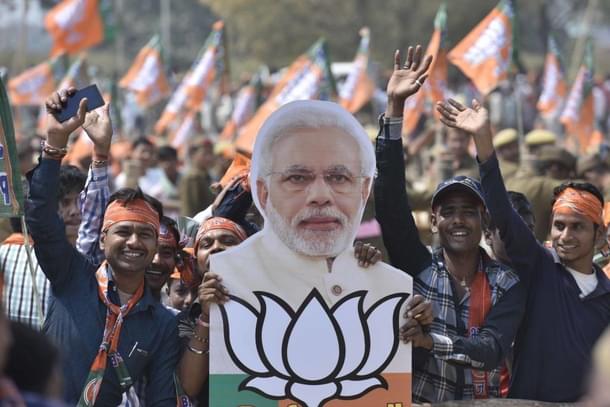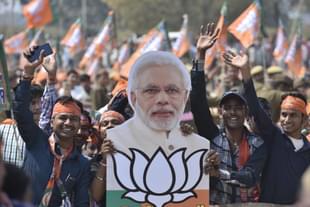Politics
'Left-Right' Vocabulary Cannot Define Hindutva; Nor Can It Describe The BJP Under Modi
Suraj S
Oct 26, 2021, 08:26 PM | Updated 08:34 PM IST
Save & read from anywhere!
Bookmark stories for easy access on any device or the Swarajya app.


Editorial Note: This article is based on 'Why BJP should be considered a Hindu Democratic Party'. It was written by Suraj S and was published on 5 March 2021.
RSS Sah-Sarakaryavah (Joint General Secretary), Dattatreya Hosabale, recently said that Hindutva is "neither left nor right".
These remarks of the RSS stalwart came at an event in New Delhi which was held to launch The Hindutva Paradigm, the latest book by RSS leader Ram Madhav.
Hosabale said in his speech that he belonged to "neither the right or the left" adding that in recent times, the world has been moving towards the right 'so that it comes to the centre'. "That is what Hindutva is all about", said Hosabale, "it is neither left nor right".
Hosabale shared that in no RSS camp is it declared that the organisation is 'rightist' and many of the ideas of Sangh were, in fact, leftist ideas.
While Hosabale was speaking on Hindutva, the same descriptors apply equally to political vehicle of Hindutva in India—the Bharatiya Janata Party (BJP). Even the BJP cannot be accurately understood or defined through the Anglophone terminology of 'left' and 'right'. This is especially true of the BJP under Narendra Modi since 2014.
For example, do you think of the following national initiatives as leftist or rightist? National electrification, universal sanitation, universal housing, nationwide access to clean water, nationwide highway transport system and universal healthcare for poor mission.
The Saubhagya Mission, started in September 2017, has achieved universal electrification of rural households, having increased from 71 per cent to 91 per cent in a year and half and full electrification cover since.
The Swacch Bharat Mission increased sanitation cover from 39 per cent to near universal at present.
Universal housing was the goal of Indira Awas Yojana started way back in 1985, before half of India’s voters (more than 50 per cent are in the 18-35 age group) were born. It is only due for completion in 2022 under the new PMAY programme that accelerated construction in 2017 , doubling rate of construction.
The Jal Jeevan Mission has already doubled tap water connections from less than 17 per cent in 2019 to over 36 per cent today. The PMJAY Ayushman Bharat mission has over 140 million card holders who have availed 17 million hospital visits since foundation of the programme. The Bharatmala programme is executing an aggressive transportation connectivity programme.
Which of these are ‘right wing’? None. These — and others — are all programmes initiated by the Narendra Modi government.
Addressing quality of life for the lowest strata of society has dominated most of the policy actions of this administration, with significant outcome improvements that enabled it to return to power with an unprecedented mandate in 2019.
Critics complain that the statistics aren’t reliable, but the political results are undeniable.
The administration’s major laws are known — the bankruptcy code, the GST act, the CAA law and the farm laws.
Let’s have a cursory look at some other new acts promulgated:
-Black Money Act 2015: a stringent act targeting illegal foreign income.
-Compensatory Afforestation Fund Act 2016: a new law to generate resources to replace forest cover cut down for timber with planting elsewhere.
-Child Labour Prohibition and Regulation Act 2016
-Maternity Benefit Act 2017: mandates generous 26 week maternity leave and creches.
-Mental Healthcare Act 2017: first national law recognising mental health needs.
-Employment Compensation Act 2017: formalises employee right to compensation.
-Right to Free and Compulsory Childrens Education 2019
And bills passed:
-Occupational Health, Safety and Working Conditions Bill
-Epidemic Diseases Bill 2020: updates previous act from 1897 to help Covid handling.
-Transgender Protection of Rights Bill 2019: first formal bill on transgender rights.
-Protection of Children from Sexual Offences Bill 2019: first formal bill targeting this topic.
-Consumer Protection Bill 2019: protects rights of consumers.
-Protection of Human Rights Bill 2019: Updates the 1993 act.
Maternity rights, children’s rights, environmental protection, mental health, transgender rights, employee compensation, occupational health and safety, consumer rights, human rights — these are the subject of already passed bills or acts from this BJP administration. They constitute standard Left-wing liberal interests (maternity rights, labour, consumer and human rights), even woke progressive leitmotifs like LGBTQ rights. And yet, the BJP is frequently described as a parochial right-wing party. The American Republicans for example have a long record of transgender discrimination, consumer rights dilution and more. The BJP instead is headed the opposite way.
So what, then, is the BJP?
Standard Anglosphere-oriented left versus right-wing political distinction does not apply in India.
It bears a review of what the centre right in the US and UK are.
The American Republicans are the party of the wealthy and the religious conservatives. They want ‘small government’, deregulation, opposed to environmental protection, in favour of cutting taxes.
In the UK, the Conservatives are the party of the upper class and wealthy, and strong supporters of the royalty. In both cases, their centre-right is the party of the socio-economic elite and that of the social conservatives.
The centre-left in those countries constitute the intellectual and labour classes, unions, and other organised groups, including immigrants who aspire to be socio-economically mobile.
In India, the situation is diametrically the opposite. The centre-left Congress is the party of the elite. The Nehru-Gandhi family running Congress are billionaires with a vast network of property, influence and patronage, a legion of lawyers, media personalities, and other influence peddlers at their disposal. This ecosystem maintains significant intergenerational wealth, is western educated and ‘think in English’. Their fundamental aim is to conserve their influence and wealth, maintained over the decades following Independence. They aren’t simply ‘convent-educated’, but went to the top prep schools in India, followed by the UK/US. They resemble the British Conservatives and American Republicans — intergenerational wealth, power and influence.
The BJP in comparison is the party of the aspirational class, small businessmen and entrepreneurs and social conservatives. It has no record of intergenerational wealth or interest at all — none of its major leaders even have families. They seek to reform the existing status quo to instead favour the aspirational class. Women, children, consumers at large, small business, the removal of all the arcane laws that enabled wealthy dynasties to safeguard their business interests across generations — the BJP’s laws reflect their impetus to reform and change.
In the Anglosphere, the right-wing, as described above, are conservatives, while the left wing are liberals. In India, while the Congress calls themselves the ‘liberals’ they are fundamentally conservative elites trying to conserve their privileged position in society. The BJP are the liberals trying to change the existing power structure to a more egalitarian broad-based one.
So, what template really fits the BJP?
The answer lies in continental Europe — Christian democracy. Swap the religion with Hinduism and consider the history of the Christian democrats — you have a political philosophy largely what the BJP professes to.
Both consider that their societies are conceived of a culture that is built out of the influence of the primary religion of the land.
Both — unlike the Anglophone right wing — see their society as composed of not a primary group but several subcommunities working towards the common good. Germany — the home of Christian democracy — was after all federated into a single country only in the second half of the nineteenth century.
Both prescribe social capitalism — between socialism of the Anglophone left (and historically the Indian Congress) and liberal capitalism of the Anglophone right.
Most fundamentally, both view secularism in common terms — that the dominant culture maintains and requires a first among equals position in society. Neither seek a theocracy, but neither are interested in a secular structure that comes at the cost of the religion that is the dominant cultural influence of the land.
Modi is best understood by comparison to the most well known Christian Democrat of the present day — Angela Merkel.
This article describes Merkel, her beliefs and how they drive her, as well as Christian Democracy in general — something both the US and UK are unfamiliar with.
Modi and Merkel both share a commitment to combating climate change — a topic the Anglophone right wing treats at best with scepticism. Under Modi, India is the only G20 nation to be on track to meet 2°C compatibility targets from the 2015 Paris Accord.
The German popular voting breakdown for and against CDU (and in favour of their main rival the SPD — Socialist Party of Germany), mirrors India. Ethnic Turks largely vote SPD, while ethnic Germans predominantly vote CDU/CSU. The voting preferences almost exactly mirror Muslims in India with regard to BJP.
In this regard, the CDU’s platform is fundamentally democratic the same way the BJP’s is. Both parties know that by appealing to the greatest common denominator of their societies, they have enough support to win.
Identity politics does not suit them. They don’t need it, and it is counterproductive to their voting base.
This is criticised as ‘electoral majoritarianism’, but primarily in the Indian context even though the CDU has essentially the same electoral base within Germany as the BJP in India.
The Anglophone West struggles to describe the BJP for the same reason it doesn’t really know or understand the continental European Christian Democrats well.
The BJP is not a parochial right-wing “fundamentalist” party. They are the same thing as the continental European Christian Democrats in an Indian context with Hinduism replacing Christianity.
The Anglophone West and their Indian cohorts — who barely understand the Christian Democrats, do not understand the BJP either. The two have fundamentally similar political backgrounds from the same timeframes — beginning late nineteenth century, but evolving post the Second World War. Both have popular leaders who express their belief in their respective religions forming the cultural base of their nations. Merkel expresses this even more explicitly than Modi: "Merkel urges Germans: stand up for Christian values".
It’s time for the BJP to be explicitly described as a Hindu democratic party. They constitute the Indian expression of the same values that the continental European Christian Democrats express. A clear expression of what they are, also frees them from the artificial constraints applied on them to fit into one of two classification categories that the Anglophone Western political view imposes upon them.
They should not be described in terminology defined by those who do not understand them or the general foundation of Hindu democracy in the first place. This freedom will give them greater clarity to pursue their policies effectively.
This article is based on 'Why BJP should be considered a Hindu Democratic Party'. It was written by Suraj S and was published on 5 March 2021.





